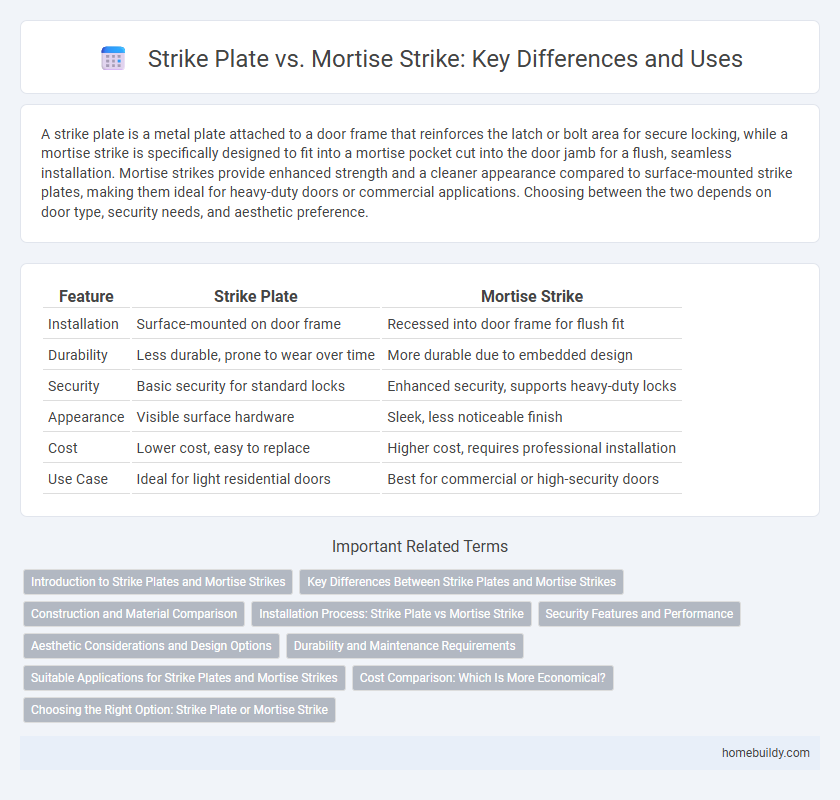A strike plate is a metal plate attached to a door frame that reinforces the latch or bolt area for secure locking, while a mortise strike is specifically designed to fit into a mortise pocket cut into the door jamb for a flush, seamless installation. Mortise strikes provide enhanced strength and a cleaner appearance compared to surface-mounted strike plates, making them ideal for heavy-duty doors or commercial applications. Choosing between the two depends on door type, security needs, and aesthetic preference.
Table of Comparison
| Feature | Strike Plate | Mortise Strike |
|---|---|---|
| Installation | Surface-mounted on door frame | Recessed into door frame for flush fit |
| Durability | Less durable, prone to wear over time | More durable due to embedded design |
| Security | Basic security for standard locks | Enhanced security, supports heavy-duty locks |
| Appearance | Visible surface hardware | Sleek, less noticeable finish |
| Cost | Lower cost, easy to replace | Higher cost, requires professional installation |
| Use Case | Ideal for light residential doors | Best for commercial or high-security doors |
Introduction to Strike Plates and Mortise Strikes
Strike plates serve as metal reinforcements installed on door frames to receive and secure latch bolts or deadbolts, ensuring proper alignment and increased security. Mortise strikes differ by being designed specifically for mortise lock systems, featuring a deeper, more robust structure to accommodate the larger latch mechanism embedded within the door. Both strike plates and mortise strikes play crucial roles in lock functionality, but their compatibility depends on the type of lock set used.
Key Differences Between Strike Plates and Mortise Strikes
Strike plates are surface-mounted metal components that reinforce door frames and provide a secure point for latchbolts to engage, typically used in standard cylindrical lock installations. Mortise strikes, designed for mortise locks, are recessed into the door frame, offering enhanced security and a cleaner look by housing the lock's bolt deeper within the frame. Key differences include installation style--surface-mounted versus recessed--and compatibility, with mortise strikes catering to heavier-duty locking mechanisms compared to the more common strike plates.
Construction and Material Comparison
Strike plates are typically made from solid steel or brass, providing robust resistance against forced entry and wear, while mortise strike plates often incorporate reinforced steel with thicker gauges to withstand the deeper mortise lock mechanism. The construction of mortise strike plates includes additional features such as extended lip designs and multiple screw holes for enhanced stability within door frames, contrasting with the simpler, flat design of standard strike plates. Material density and structural reinforcement in mortise strikes result in superior durability and security compared to conventional strike plates, making them ideal for heavy-duty locking systems.
Installation Process: Strike Plate vs Mortise Strike
Installing a strike plate generally involves surface mounting onto the door frame using screws aligned with the latch, making it a straightforward process suitable for most standard doors. Mortise strike installation requires chiseling a recessed pocket into the door jamb to fit the strike plate flush, ensuring a more secure and aesthetically seamless fit. Accurate measurements and proper alignment are critical in both installations to guarantee smooth door operation and enhanced security.
Security Features and Performance
Strike plates designed for surface mounting offer essential reinforcement by securing the latch bolt against forced entry, while mortise strike plates integrate into door frames, providing enhanced stability and resistance to kick-ins. Mortise strike plates typically feature deeper, more robust metal construction with extended screws anchoring into the framing studs, significantly improving door security performance compared to standard strike plates. Choosing a mortise strike plate elevates protection by distributing impact forces more effectively and minimizing vulnerabilities commonly exploited in break-in attempts.
Aesthetic Considerations and Design Options
Strike plates offer a sleek, minimalistic look ideal for modern door designs, while mortise strikes provide a more robust and traditional appearance suitable for classic interiors. Design options for strike plates often include polished brass, stainless steel, and matte finishes, enhancing visual appeal through subtle customization. Mortise strikes typically feature intricate craftsmanship and decorative styles, catering to vintage or ornate architectural aesthetics.
Durability and Maintenance Requirements
Strike plates offer moderate durability and straightforward maintenance, suitable for standard door frames, while mortise strikes provide enhanced durability due to their recessed installation, which better withstands forced entry. Mortise strike plates require more precise fitting and occasional adjustment to maintain alignment, but their robust design reduces wear over time compared to surface-mounted strike plates. Choosing between the two depends on balancing the need for long-term durability with maintenance capabilities tailored to the door's security requirements.
Suitable Applications for Strike Plates and Mortise Strikes
Strike plates are ideal for standard door installations requiring surface-mounted hardware, commonly used in residential settings for lightweight doors and interior applications. Mortise strikes are suited for commercial or heavy-duty doors where a mortise lock is installed, providing enhanced security and durability by housing the lock mechanism within the door edge. Selecting between strike plates and mortise strikes depends on door type, security needs, and installation complexity.
Cost Comparison: Which Is More Economical?
Strike plates generally offer a more cost-effective solution compared to mortise strikes due to simpler design and easier installation processes, resulting in lower labor expenses. Mortise strikes, designed for heavier-duty applications, tend to have higher material and customization costs. For budget-conscious projects, standard strike plates provide economical durability without compromising security.
Choosing the Right Option: Strike Plate or Mortise Strike
Choosing between a standard strike plate and a mortise strike depends on the door's security requirements and frame compatibility. Mortise strikes offer enhanced strength and are ideal for heavy-duty doors or high-security applications, while standard strike plates suit typical residential doors for basic latch engagement. Proper alignment and installation are vital to ensure optimal lock performance and durability regardless of the selected strike type.
Strike plate vs mortise strike Infographic

 homebuildy.com
homebuildy.com